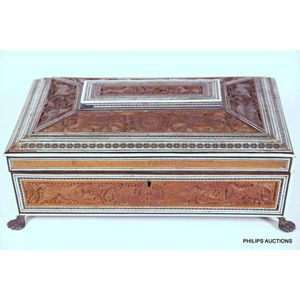Anglo Indian Sandalwood Sewing Box with Sadeli Mosaic Inlay
You must be a subscriber, and be logged in to view price and dealer details.
Subscribe Now to view actual auction price for this item
When you subscribe, you have the option of setting the currency in which to display prices to $Au, $US, $NZ or Stg.
- Verso - Verso is the "back" side of a sheet of paper, art work, coin or medal. The front side is "recto".
- Ivory - Ivory is a hard white material that comes from the tusks of elephants, mammoth, walrus and boar, or from the teeth of hippopotamus and whales. The ivory from the African elephant is the most prized source of ivory. Although the mammoth is extinct, tusks are still being unearthed in Russia and offered for sale.
Ivory has been used since the earliest times as a material for sculpture of small items, both in Europe and the east, principally China and Japan.
In Asia ivory has been carved for netsuke, seals, okimono, card cases, fan supports, animals and other figures and even as carved tusks.
In the last 200 years in Europe ivory has been used to carve figures, for elaborate tankards, snuff boxes, cane handles, embroidery and sewing accessories, in jewellery and as inlay on furniture. Its more practical uses include being used for billiard balls, buttons, and a veneers on the top of piano keys.
The use and trade of elephant ivory have become controversial because they have contributed to Due to the decline in elephant populations because of the trade in ivory, the Asian elephant was placed on Appendix One of the Convention on International Trade in Endangered Species (CITES), in 1975, and in January 1990, the African elephant was similarly listed. Under Appendix One, international trade in Asian or African elephant ivory between member countries is forbidden. Unlike trade in elephant tusks, trade in mammoth tusks is legal.
Since the invention of plastics, there have been many attempts to create an artificial ivory - Sandalwood - Sandalwood is a heavy, yellow coloured and very fine-grained timber, which has a fragrance which lasts for many decades, and acts as a deterent to moths and insects.
In the British colonial era, sandalwood was imported into Britain from India, and the wood also used within India for the manufacture of Anglo-Indian furniture.
Becasue it does not have a distinct grain pattern, sandalwood was not used for the exterior surfaces of furniture, but was put to use for drawer and box linings, where the aroma was noticeable one the object was opened. it was also used to manufacture small objects (treen).
Nowadays sandalwood is commercially grown with Australia the largest producer. As well as producing timber, oil is extracted for use in the manufacture of perfumes.
This item has been included into following indexes:
Visually similar items

A wooden jewellery box, with mother-of-pearl and brass inlay, two compartment levels, velvet interior. 25.5 x 18 x 13.5 cm, with costume jewellery content

Late 19th century Anglo-Indian teak blanket box the whole elaborately carved with florals, scrolls on bun feet

An Anglo-Indian Vizagapatam sandalwood sewing box, mid 19th century, the casket shaped box finely carved in relief with animals and foliate motifs in low relief between bone and sadeli mosaic borders, the complete compartmentalised interior with petite car

A large Chinese carved wooden table screen with mother-of-pearl inlay, Republic period the screen carved in high relief with a newly-wed couple meeting probably the god of marriage set in a garden landscape, verso with symbols of fortuity and longevity, th
